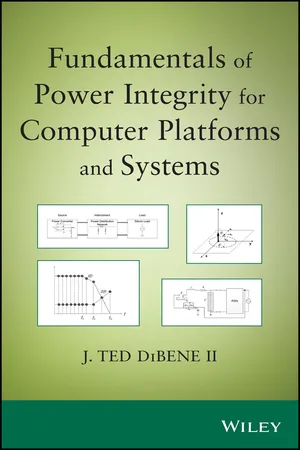
- English
- ePUB (mobile friendly)
- Available on iOS & Android
Fundamentals of Power Integrity for Computer Platforms and Systems
About This Book
An all-encompassing text that focuses on the fundamentals of power integrity
Power integrity is the study of power distribution from the source to the load and the system level issues that can occur across it. For computer systems, these issues can range from inside the silicon to across the board and may egress into other parts of the platform, including thermal, EMI, and mechanical.
With a focus on computer systems and silicon level power delivery, this book sheds light on the fundamentals of power integrity, utilizing the author's extensive background in the power integrity industry and unique experience in silicon power architecture, design, and development. Aimed at engineers interested in learning the essential and advanced topics of the field, this book offers important chapter coverage of fundamentals in power distribution, power integrity analysis basics, system-level power integrity considerations, power conversion in computer systems, chip-level power, and more.
Fundamentals of Power Integrity for Computer Platforms and Systems:
- Introduces readers to both the field of power integrity and to platform power conversion
- Provides a unique focus on computer systems and silicon level power delivery unavailable elsewhere
- Offers detailed analysis of common problems in the industry
- Reviews electromagnetic field and circuit representation
- Includes a detailed bibliography of references at the end of each chapter
- Works out multiple example problems within each chapter
Including additional appendixes of tables and formulas, Fundamentals of Power Integrity for Computer Platforms and Systems is an ideal introductory text for engineers of power integrity as well as those in the chip design industry, specifically physical design and packaging.
Frequently asked questions
Information
Chapter 1
Introduction to Power Integrity
1.1 Definition for Power Integrity

1.2 Historical Perspective on Power Integrity Drivers
Table of contents
- Cover
- Title Page
- Copyright
- Dedication
- Foreword
- Preface
- Acknowledgments
- Acronyms
- Chapter 1: Introduction to Power Integrity
- Chapter 2: Introduction to Platform Power Conversion
- Chapter 3: Review of Electromagnetic Field and Circuit Representations
- Chapter 4: Power Distribution Network
- Chapter 5: Power Integrity Time-Domain and Boundary Analysis
- Chapter 6: System Considerations for Power Integrity
- Chapter 7: Silicon Power Distribution and Analysis
- Appendix A: Table of Inductances for Commonly Used Geometries
- Appendix B: Spherical Coordinate System
- Appendix C: Vector Identities and Formulae
- Index
- End User License Agreement